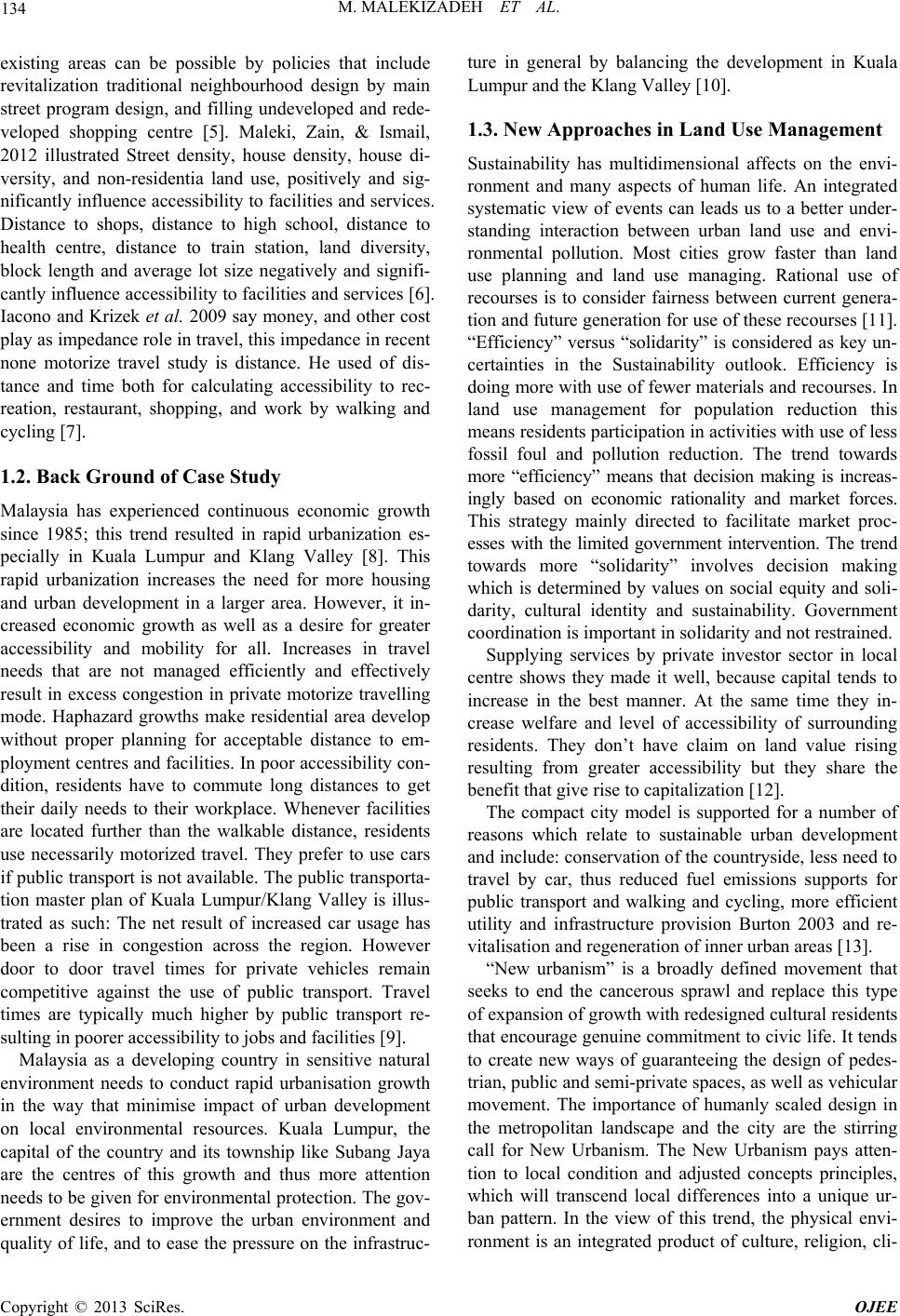
M. MALEKIZADEH ET AL.
134
existing areas can be possible by policies that include
revitalization traditional neighbourhood design by main
street program design, and filling undeveloped and rede-
veloped shopping centre [5]. Maleki, Zain, & Ismail,
2012 illustrated Street density, house density, house di-
versity, and non-residentia land use, positively and sig-
nificantly influence accessibility to facilities and services.
Distance to shops, distance to high school, distance to
health centre, distance to train station, land diversity,
block length and average lot size negatively and signifi-
cantly influence accessibility to facilities and services [6].
Iacono and Krizek et al. 2009 say money, and other cost
play as impedance role in travel, this impedance in recent
none motorize travel study is distance. He used of dis-
tance and time both for calculating accessibility to rec-
reation, restaurant, shopping, and work by walking and
cycling [7].
1.2. Back Ground of Case Study
Malaysia has experienced continuous economic growth
since 1985; this trend resulted in rapid urbanization es-
pecially in Kuala Lumpur and Klang Valley [8]. This
rapid urbanization increases the need for more housing
and urban development in a larger area. However, it in-
creased economic growth as well as a desire for greater
accessibility and mobility for all. Increases in travel
needs that are not managed efficiently and effectively
result in excess congestion in private motorize travelling
mode. Haphazard growths make residential area develop
without proper planning for acceptable distance to em-
ployment centres and facilities. In poor accessibility con-
dition, residents have to commute long distances to get
their daily needs to their workplace. Whenever facilities
are located further than the walkable distance, residents
use necessarily motorized travel. They prefer to use cars
if public transport is not available. The public transporta-
tion master plan of Kuala Lumpur/Klang Valley is illus-
trated as such: The net result of increased car usage has
been a rise in congestion across the region. However
door to door travel times for private vehicles remain
competitive against the use of public transport. Travel
times are typically much higher by public transport re-
sulting in poorer accessibility to jobs and facilities [9].
Malaysia as a developing country in sensitive natural
environment needs to conduct rapid urbanisation growth
in the way that minimise impact of urban development
on local environmental resources. Kuala Lumpur, the
capital of the country and its township like Subang Jaya
are the centres of this growth and thus more attention
needs to be given for environmental protection. The gov-
ernment desires to improve the urban environment and
quality of life, and to ease the pressure on the infrastruc-
ture in general by balancing the development in Kuala
Lumpur and the Klang Valley [10].
1.3. New Approaches in Land Use Management
Sustainability has multidimensional affects on the envi-
ronment and many aspects of human life. An integrated
systematic view of events can leads us to a better under-
standing interaction between urban land use and envi-
ronmental pollution. Most cities grow faster than land
use planning and land use managing. Rational use of
recourses is to consider fairness between current genera-
tion and future generation for use of these recourses [11].
“Efficiency” versus “solidarity” is considered as key un-
certainties in the Sustainability outlook. Efficiency is
doing more with use of fewer materials and recourses. In
land use management for population reduction this
means residents participation in activities with use of less
fossil foul and pollution reduction. The trend towards
more “efficiency” means that decision making is increas-
ingly based on economic rationality and market forces.
This strategy mainly directed to facilitate market proc-
esses with the limited government intervention. The trend
towards more “solidarity” involves decision making
which is determined by values on social equity and soli-
darity, cultural identity and sustainability. Government
coordination is important in solidarity and not restrained.
Supplying services by private investor sector in local
centre shows they made it well, because capital tends to
increase in the best manner. At the same time they in-
crease welfare and level of accessibility of surrounding
residents. They don’t have claim on land value rising
resulting from greater accessibility but they share the
benefit that give rise to capitalization [12].
The compact city model is supported for a number of
reasons which relate to sustainable urban development
and include: conservation of the countryside, less need to
travel by car, thus reduced fuel emissions supports for
public transport and walking and cycling, more efficient
utility and infrastructure provision Burton 2003 and re-
vitalisation and regeneration of inner urban areas [13].
“New urbanism” is a broadly defined movement that
seeks to end the cancerous sprawl and replace this type
of expansion of growth with redesigned cultural residents
that encourage genuine commitment to civic life. It tends
to create new ways of guaranteeing the design of pedes-
trian, public and semi-private spaces, as well as vehicular
movement. The importance of humanly scaled design in
the metropolitan landscape and the city are the stirring
call for New Urbanism. The New Urbanism pays atten-
tion to local condition and adjusted concepts principles,
which will transcend local differences into a unique ur-
ban pattern. In the view of this trend, the physical envi-
ronment is an integrated product of culture, religion, cli-
Copyright © 2013 SciRes. OJEE